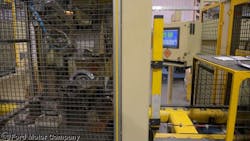3D mapping system used to inspect gears for U.S. car maker
Engineers at Ford Motor Company are using 3D mapping in what may be the first application of the technology in the automotive industry. By creating 3D images, Ford says it is able to better analyze rear axle parts of its F-series of pickup trucks, which reportedly helps lead to a smoother and quieter ride.
The use of the 3D mapping system, which was developed by Madison, Wis.-based Automated Vision and ATM Automation in Livonia, Mich., came about because the hypoid gears used on the rear axle ring and pinion make it impossible to see both sides of each gear tooth in a single image.
First, a spray station was built to evenly apply the marking compound for the gears, explained Gino Catenacci, engineering manager at Ford Motor Company. Once the marking compound was evenly and consistently applied, the gear set is rolled and the contact pattern, or gear mesh pattern, is created. From there, digital line scan cameras and infrared lights take images of the gear and break it down into the individual teeth to determine if anything has shifted and if it meets specifications.
The photogrammetric pattern reader that Ford uses has a pair of cameras and infrared lights to capture 9,000 1024x1-pixel images from each side of every gear tooth as the gear rotates. The captured 2D image slices are then converted into a single 3D image to compare against an ideal computer model of the gears contained in the processing system. When gears don’t meet the established specifications, they are discarded.
View the Ford press release.
Share your vision-related news by contacting James Carroll, Senior Web Editor, Vision Systems Design
To receive news like this in your inbox, click here.
About the Author

James Carroll
Former VSD Editor James Carroll joined the team 2013. Carroll covered machine vision and imaging from numerous angles, including application stories, industry news, market updates, and new products. In addition to writing and editing articles, Carroll managed the Innovators Awards program and webcasts.
